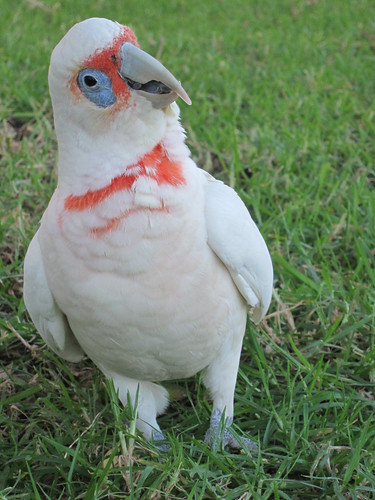 Long-billed Corella at Centennial Park, Sydney, NSW, Australia. Photo: Rachel TaftThe Corella seems to be public enemy number one in some parts of Victoria, and here in the South West they're also causing a bit of a ruckus.
Long-billed Corella at Centennial Park, Sydney, NSW, Australia. Photo: Rachel TaftThe Corella seems to be public enemy number one in some parts of Victoria, and here in the South West they're also causing a bit of a ruckus.
You often hear Corellas long before you see them - and usually at times of the day when their noisy squawking is less than welcome, but what exactly are these loud, restless birds up to?
Corellas are natives - they're members of the Cockatoo family and their distribution in Victoria is fairly restricted although as retired DSE employee Phillip Du Guesclin points out, they do seem to be expanding their range.
They certainly expanded one recent evening around six pm when I was at the Warrnambool botanic gardens, the perfect time for what seemed like a nice relaxing picnic tea until an incredibly loud jumble of squawking voices flew in and proceeded to race from tree to tree, screeching and scrabbling with as much volume as they could muster.
The really interesting thing was how dead quiet it was once they left - their voiceboxes are truly capable of producing some major decibels.
Phillip explains they do have different calls and seem to be very social birds - particularly at this time of the year where they're in a post breeding phase and are building up flocks.
The Corella usually breeds in early to late spring, nesting in hollows to have their babies.
In late summer though when there are more juvenile birds around, they tend to congregate to 'better utilise food sources'.
They dig most of their food out of the ground and are particularly fond of an introduced plant known as onion grass bulbs because most of their native foods have disappeared.
The other odd thing about the flock I saw in the botanic gardens was their highly sporadic flying - often a couple of birds would break away from the flock and dart around before rejoining the other birds. Phillip calls this a sort of 'pre roost acrobatics'.
They've also been blamed for stripping the tops off the pine trees around Warrnambool but once again, as Phillip explains, they do this partly to help keep their beaks clean and trimmed.
Thirty years ago they weren't seen in such great numbers around the south west but an expansion of cereal crops has encouraged the birds to move further down, and the dry conditions in the north of the state have made it harder for them to dig in the ground.
They're fascinating, funny birds to watch, but it's the noise which they're most famous for and which really gets on people's nerves.
Phillip wraps them up by saying 'they're like Collingwood - you either love them or you hate them'.